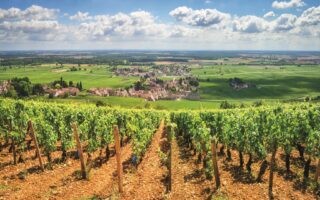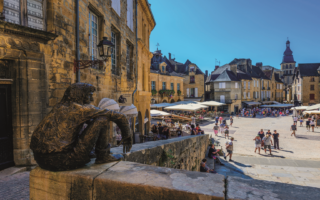Barn Renovation in the Lot
Creating a Dream Come True
Leslee Carsewell, originally from the East Coast of the US fell in love with France at an early age and dreamt of one day having a house there. Here she tells the story of her barn purchase and renovation.
My interest in France began when my parents took me to Paris when I was 15. It was a true coup de foudre. I was dumbstruck. Despite having grown up with New York City as my cultural base, I loved Paris more than any place I had ever been.
When I met my now ex husband, we found we both had a love for France and made many many visits all over the various regions, starting in the early 70’s. I loved the French language and painting, so it all came to life while driving through the countryside. We made our first trip to the Lot/Dordogne region in 1979 and I found it truly tranquil and incredibly beautiful. I was living in the Midwest then and found the contrast to be startling. It was far more like the vegetation on the East Coast, where I had spent many hours walking as a child.
In 1980, I had the good fortune to make a serendipitous meeting with an Australian/Dutch couple, while we were all living in Minneapolis. Molly, now my friend of almost 30 years was bird watching in a park where I was walking my dog and by coincidence, she had the very same type – an Irish Terrier.
We began to chat and found we had a common interest in France, and the Perigrod/Quercy region in particular. As our friendship evolved we visited them often in their village home and always had the dream to buy a house in the region. In 1997 we bought the barn and Molly and Henk live just down the road, a mere 2.8 km away – a most fortuitious meeting almost 30 years ago!
The barn was discovered during the Christmas Holidays in 1996. We were on a randonee with Molly and Henk when we stumbled on the barn for sale. The site was gorgeous in a sleepy hamlet. We rushed to town to meet the estate agent and fixed a time l’apres-midi for a viewing. We decided on the spot to buy it – the most impulsive thing I have ever done, but with years of dreaming to back it up.
The purchase and subsequent renovation and conversion of the barn into a house was a real journey. The barn was just that, dirt floors, stone walls, 2 hay lofts and mangers – c’est tout! It took a year to get the permis de construire approval.
We had to meet with various approval levels to discuss the style of windows, the sizes of the window panes (which the regional architect subsequently enlarged) and the multiple page plans had to be revised several times. The mairie of my commune helped us, as did my friend Molly. My French has vastly improved since then.
Then it took almost 3 years of work to complete. I had one main Englishman, Mike, and two of his colleagues who came and went depending on what needed to be completed.
I reused as much material as I could from the existing barn, creating a real sense of “rusticity”, on one hand, yet very comfortable. The huge stone fireplace is made from the stones that were saved where windows were cut in to the north side of the building. The mason was shocked at my idea as his
was to create something more bourgeois. But he was happy with the result in the end.
The kitchen counters are made from the manger walls which I insisted Mike make 95cm, rather than the normal, lower French height. The vanities in the bathrooms were custom made in a rustic style to mimic the style of the poutres above.
While preparing the roof to put on the new tiling, removing the tuiles mechanics, dating from the 40’s and replacing them with tuiles plats (specified by the regional architect for the Perigord), we discovered that most of the poutres were basically powder so the whole of the roofing structure had to be rebuilt, prior to laying the roof. This created delays in the overall completion. I then reused the poutres that were not rotten to make the staircases to the two hay lofts, which became the ensuite bedrooms at opposite ends of the house.
The kitchen area and the foyer and cave areas were below ground, so they had to be blasted out in order to lay the flooring.
All the walls both inside and out were repointed, a monumental job at any height but more so with the soaring exterior walls. I also had a damp problem along the north wall which was solved by trenching the earth and cementing over it. The house is now very dry. And very toasty, despite its size and volume, in the winter months.
I had French artisans for the plumbing and fireplace. I suspect that all of them put on a head of steam when they knew I was coming from the US to check on the progress. I recall begging Mike to make the barn habitable so that I could spend my 50th birthday there. That did not happen!! At the time we began doing all this, we did not have email access, so I was constantly sending revised detail drawings and sketches by fax.
Since 2005, I have put in garden areas, and the stone for the walls of the gardens were discovered and dug up in an area below the barn. Clearly there was some other type of structure there originally.
It has not been easy to find connections to appropriate artisans of various kinds. I think it is far easier to accomplish if one is on site and livng in the region.
In the last few years since I have been spending months at a time there, I find I am more accepted in my community and therefore have the ear of my French neighbors who have helped me to find a great infra-structure to watch and maintain the house in my absence.
I kept a very neutral color palate throughout so that the immediate architecture of the space was noticeable first hand. I chose a light color stone flooring and it really added to the overall sense of volume. At the time, my other choice was terra cotta, but I was concerned it would just visually take over rather than blend in. There are many more choices available now. One thing I regret, but it really was not available at the time, was that I would have loved to put geo-thermal heating in, from the standpoint of being ecological, and also not having to look at large radiators!
The spaces are very serene, and this goes hand in hand with the views of my little valley. Even though I am a designer, my goal was not to impose too much of myself into the space, but rather let the space dictate how the building should evolve. I think I have achieved that.
I love most when French people come over and are taken with the ambiance, often commenting how real the place feels. As you know, houses are never finished, so its an ongoing process, one that begs for my time when I am there and beckons my heart when I am not.
© Leslee Carsewell 2007
Need design help with your renovation project?
Get in touch with Leslee by email: [email protected]
When she is not staying there herself, Leslee’s beautiful barn is available to rent, contact her using the email above.
To find out more about Leslee’s widely acclaimed photographs of the Lot and Dordogne, please visit: Capturing the Light – Images of the Lot and Dordogne.
Share to: Facebook Twitter LinkedIn Email
More in countryside, estate agents, garden, language, renovation, villages, work
Leave a reply
Your email address will not be published. Required fields are marked *



